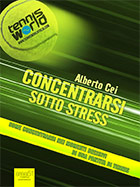Inside Sport Psychology
Costas I. Karageorghis and Peter C. Terry
Human Kinetics Publisher, 2011, p.235
Karageorghis and Terry provide an excellent overview of sport psychology, regarding motivation, self-confidence, anxiety, emotion, concentration, visualization and self-hypnosis. Also mood and music on performance are well treated because they are one of the main authors’ interest. All the themes are presented not only from the scientific side but many anecdotes and exercises are included. I highly recommend this for anyone interested in learning about sport psychology or people looking to improve athletic performance or even to learn general mental skills for life.
In the first chapter entitled “Sport psychology applications” the authors talk about skill acquisition that underlie top performance and about the concept that too often the athletes’ performances are not very consistent during a season and the reason is most of the time related to a reduced mental preparation. At this proposal they ask to the readers to take a moment to reflect on all the excuses they commonly use to explain their worst performances. In this way, Karageorghis and Terry introduce the readers to one of the main aspects of book, that is to propose theories and psychological techniques but also exercises to practice in order to be actively involved in the topics treated. This permit to the readers to be inside the themes of each chapter and to read it in a ease way. The second chapter is about motivation and, after some theoretical introductions, he athletes are driven to identify their main strong and weak points and how to become totally involved, in a flow experience that represents the peak of the intrinsic motivation. The authors look also to the youth coaches when they explain about the relevance of a mastery climate during the training to sustain this intrinsic motivation, de-emphasizing social comparisons. The following two chapters are about self-confidence and anxiety. Confidence is so important psychological factors that could increase or destroy the performance, starting from this suggestions the authors introduce the Bandura’s self-efficacy approach and try to propose for each of its dimensions practical strategies to improve and sustain the self-confidence using the athletes’ imagery and self-talk skills. The anxiety is treated following the best known approach to explain this phenomenon, its symptoms and responses and the main relaxation techniques to reduce it. Like for the other topics many example of great sport athletes are provided to show that to choke under pressure is something that happens also at the top performers. The book has one of the best explanation of the relation between mood and performance, the authors introduce this topic, show how to assess it and explain how they used it in the daily work with the athletes also before the most important events. Relation between food and mood are also well described in a way that I believe all the readers will find very useful. Practical suggestions are also provided to show how the self-talk can be used to change the dominant mood in specific time. The chapter about concentration as the previous describe techniques for a better use of this skill; interesting is the section where the authors provide the suggestions for future attentional training based on the use of new technologies and the web site to explore at this regards. To fulfill the athletes’ potential is necessary to practice visualization and self-hypnosis and the following chapter is devoted to these topics. The last one is about the power of sound, and it’s more related to the Karageorghis’s work in this field. It’s a very useful chapter because usually the sport psychology books talk only in general terms about the music role in training and before the beginning of sport events. We find inside the experiences of the athletes and for someone like the marathoner Paula Radcliffe the music helps her to do much harder workout, while for the double Olympic decathlon athlete, Daley Thompson, the music is not necessary because he is so immersed in his training. In any case, in the chapter the authors talk about the important relation between exercise intensity and preferred music tempo and provide a long list of popular tracks for sport and exercise and which are the useful web sites for planning music programs.




